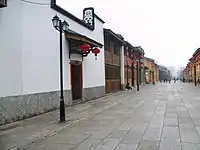Sanfang Qixiang
Sanfang Qixiang (Chinese: 三坊七巷; pinyin: sān fāng qī xiàng; Foochow Romanized: Săng-huŏng-chék-háe̤ng), literally Three Lanes and Seven Alleys, is a historic and cultural area in the city of Fuzhou.


Its name is derived from the three lanes (Chinese: 坊; pinyin: fāng; Foochow Romanized: huŏng) and the seven alleys (Chinese: 巷; pinyin: xiàng Foochow Romanized: háe̤ng) that comprise the area. These are namely:
- Yangqiao Alley (Chinese: 杨桥巷)
- Langguan Alley (Chinese: 郎官巷)
- Ta Alley (Chinese: 塔巷)
- Huang Alley (Chinese: 黄巷)
- Anmin Alley (Chinese: 安民巷)
- Gong Alley (Chinese: 宫巷)
- Jipi Alley (Chinese: 吉庇巷)
The district is trisected by the north-south thoroughfares Tonghu Road (Chinese: 通湖路) and Nanhou Street (simplified Chinese: 南后街; traditional Chinese: 南後路), and bounded by Bayiqi Road (Chinese: 八一七路) to the east and Baima Road (simplified Chinese: 白马路; traditional Chinese: 白馬路) to the west.

Covering a total area of 0.38 square kilometers (0.15 sq mi), it is celebrated as an architectural museum of Ming and Qing dynasty buildings, including numerous National Designated Monuments such as the historic residences of notable figures. Because of the high number of rich, famous and powerful residents, counting 400 in total over the past few centuries, this area has been dubbed the 'Beverly Hills' of imperial China.[1] Since 2015, it has been designated as a 5A-Rated Tourist Attraction by the Ministry of Culture and Tourism.[2]
Some of its notable former residents include:
- Zhang Jing
- Lin Zexu
- Chen Baochen
- Zheng Xiaoxu
- Shen Baozhen
- Sa Zhenbing
- Yan Fu
- Lin Shu
- Bing Xin
- Lu Yin
- Lin Huiyin
- Lin Juemin
- Wang Zhu
- Shu Chun Teng
- Deng Tuo
The area is considered a classic example of the "residential ward" or lǐfāng system (Chinese: 里坊制; pinyin: lǐfāng-zhì), a traditional form of urban planning dating back as early as the Tang dynasty.[3] Thanks to its status as a "living fossil" of such a system, it was inscribed on the UNESCO World Heritage Tentative List in 2013,[4] and later designated a National Historic and Cultural Street by the Ministry of Housing and Urban-Rural Development and State Administration of Cultural Heritage in 2015.[5] Owing to the extraordinary efforts to protect the historic fabrics from Sanfang Qixiang Administration,[6] it was awarded an honorable mention of the 2015 UNESCO Asia-Pacific Heritage Awards.[7]
References
- CNN, "Fuzhou's Sanfang Qixiang: The 'Beverly Hills' of imperial China", 1 November 2017.
- "[文化和旅游部]国家5A级景区查询_便民服务_服务_中国政府网". bmfw.www.gov.cn. Retrieved 20 June 2021.
- Li, Mengbi; Xie, Jing (July 2023). "Social and Spatial Governance: The History of Enclosed Neighborhoods in Urban China". Journal of Urban History. 49 (4): 723–744. doi:10.1177/00961442211040460. ISSN 0096-1442.
- UNESCO World Heritage Center, "SanFangQiXiang", Retrieved on 10 October 2015
- Ministry of Housing and Urban-Rural Development, "住房城乡建设部 国家文物局于公布第一批中国历史文化街区的通知", 3 April 2015. Retrieved on 3 April 2015.
- Sanfang Qixiang Administration, "三坊七巷管理委员会", Retrieved on 10 October 2015
- UNESCO Bangkok. "2015 UNESCO Asia-Pacific Heritage Awards Winners Announced", 1 September 2015. Retrieved on 1 September 2015.